Selection and preparation of soil for sowing
All plants require optimally comfortable conditions for germination, namely, light, loose, nutritious and moisture and air permeable soil. Flowers in this regard are especially demanding, since their root system is much less developed than the rhizomes of vegetable crops, which means that any "complication" of the soil will affect their development to a greater extent.
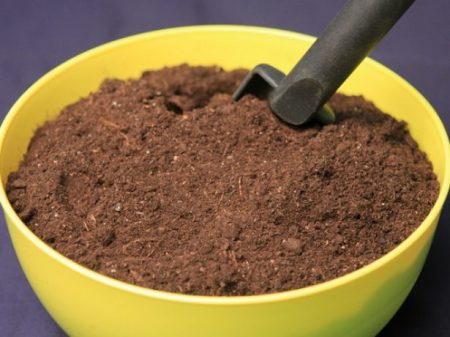
You can buy soil for petunia seedlings or mix it yourself. By the way, self-prepared soil will give you a guarantee that there are no pests or pathogens in it.
So, the soil substrate is prepared from several components: sand, peat, loamy soil. All compound soil mixtures should be taken in equal amounts:
- Peat is an irreplaceable component of any seedling soil, as it is sterile. You can use both low-lying (black) peat, which is famous for being more nutritious and low-acid, and horse (red) peat - due to its loose structure and ability to moisture resistance, it is the best suited for growing petunia seedlings.
- The sand present in the composition of the soil gives it looseness and porosity. By the way, only white or gray river sand is suitable.
- The composition should also contain turf, since nutrients are concentrated in it. And if there are not enough organic elements in it, then vermicompost or compost is added to the mixture.
 Tip: If you are not sure about the nutrient content of the soil, you can increase it with various additives. For example, one of the proven remedies is the drug "Epin", which provides plants with rapid growth. Means "Powder" gives excellent germination to seeds. And a rock called "Perlite" will help to loosen the earth.
Tip: If you are not sure about the nutrient content of the soil, you can increase it with various additives. For example, one of the proven remedies is the drug "Epin", which provides plants with rapid growth. Means "Powder" gives excellent germination to seeds. And a rock called "Perlite" will help to loosen the earth.
It doesn't matter if the soil is prepared on your own or bought in a store, you first need to disinfect it. This can be done in two ways: ignite in the oven at a temperature above 100 degrees or spill with hot water in which potassium permanganate is diluted
Only after these manipulations, the land is packaged in seedling containers and crops are sown.
Care
Petunia loves grooming and, in return, pleases the eye with its abundant flowering. Having made the first pick of the seedlings and when the first leaves appear, the plant must be fed. To do this, use:
- For petunia to grow well, you need nitrogen;
- For buds - phosphorus and potassium.
- Foliar dressing is carried out with fertilizers with microelements;
- For a beautiful look, petunias need iron;
- The plant is also very fond of potassium monophosphate.
They also use mullein for fertilization, which was infused before. The plant has not whimsical watering requirements, it is drought-resistant, can tolerate high humidity for a long time, and stops flowering with heavy rainfall. Resistant to cold weather, top dressing is done every 20 days. With proper care, the plant does not get sick, so it is advisable not to overdo it with watering and feeding. The plant needs to be weeded periodically, so the plant is cleared of weeds and gets air access. In inclement weather, pots, pots are brought into the room so that the plants are not damaged.

Growing seedlings
There is a certain order of planting petunias for seedlings, and it includes several stages:
- Soil preparation - roasting in the oven or watering with potassium permanganate to get rid of bacteria that cause black leg seedlings.
- A container with a transparent lid and half filled with prepared soil.
- We put seeds in the prepared rows at a distance of 3 cm and do not sprinkle them with earth, since they need light for germination.
- We put a thin layer of snow on top of no more than 2 cm.
- Cover the bottle or other container with a lid and place in a warm place.
If the place where the dishes with the seeds are sown is warm and light enough, then the seeds germinate after a week. If the seedlings are not friendly, then you can water them by spraying with a special solution prepared from diluted vitamin B12 and 500 gr. water. This will increase the chances for germinating seeds.
There are several ways to grow seedlings.
In a bottle
Before you start growing seedlings, you need to have everything you need at hand for this. You need a container with a transparent lid, for this you can cut a 2 or 5 liter plastic bottle of the required size along the length. But when cutting, you need to leave an area of about 15 cm. Not cut, so that the bottle opens and closes. Pour loose nutrient soil into the lower part. If it is dry, then we moisten it with a spray bottle and make rows for sowing seeds with a ruler.
It is necessary to pay attention that the seeds are granular. Then their germination will be much easier.
Then we close the bottle and glue it in two or three places with a strip of tape so that the greenhouse conditions inside it are preserved. Once a day, it must be opened for airing, so that the seeds do not rot from an excess of heat and moisture.
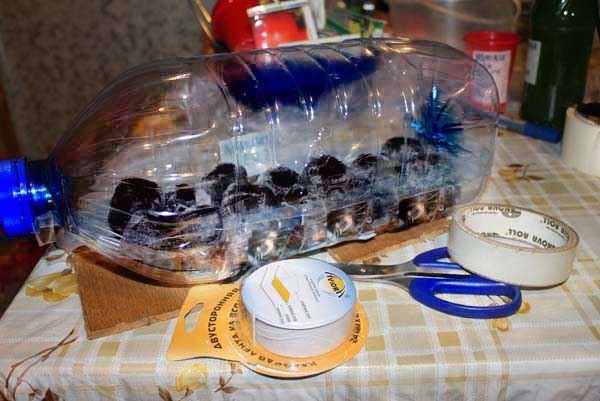
In peat tablets
There is another way for growing petunia seedlings - this is planting seeds in peat tablets. They are placed inside the container, watered and one seed is placed in each tablet. Seeds planted in this way will not cause any trouble for the entire period of their growth.
After the seeds germinate, they begin to harden, accustoming them to air. To do this, on the first day the lid is left open for 15 minutes, on the second day it can be left for half an hour, and by the end of the fifth day it has been left open for 4 hours. It should be noted that, while accustoming the seedlings to the absence of a greenhouse climate, all manipulations are carried out in a place where direct sunlight does not fall. When the time for keeping the seedlings without a lid reaches 8 hours, then it will no longer be possible to cover it.
Watering should be done carefully at the root, either with bottom watering, or with a small syringe or syringe. The earth is poured along with the development of the root system of the plant.
The first pick of petunia sprouts is done when there are three true leaves on it. With a small spoon, the sprout is taken out and rolled into a small glass filled with nutrient mixture for growing seedlings. The sprout deepens to the cotyledonous leaves. Follow-up care consists of watering and spraying with warm water, since the air is very dry during the cold season.

Picking
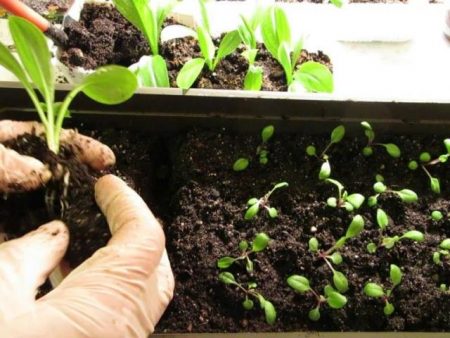
So that the seedlings do not crowd each other and do not stretch out, they are dived, that is, they are seated in rows at a greater distance, shortening the main root by one third.
A pick is prescribed at the time when 2-3 true leaves appear on the seedlings of petunias (not to be confused with cotyledons). Presumably this will happen 3-4 weeks after the sowing work.
Please note: picking can be done a little earlier, when there are only cotyledonous leaves on the shoots. This is done mainly if necessary, for example, if some disease has appeared on some of the seedlings and you urgently need to save healthy sprouts.
Light and nutritious soil is poured into the seedling containers, which is well moistened with warm water before the transplantation procedure
For picking, large-volume containers are selected, with holes at the bottom for the drain of excess water. Light and nutritious soil is poured into the seedling containers, which is well moistened with warm water before the transplantation procedure.
Tip: for transplanting, use fresh soil, abundantly fertilized with humus and mineral elements.
Diving is carried out with the help of a diving peg, with which a petunia bush is pryed and carefully transferred together with a part of the ground at the root to a new place. The sprout is deepened up to the cotyledon leaves (they must remain on the surface)
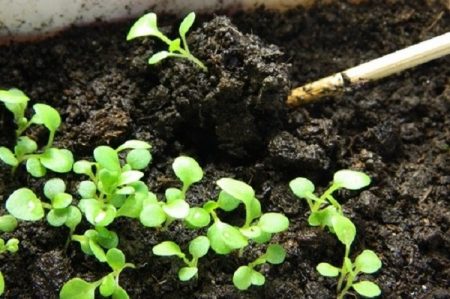
Experts recommend diving petunia seedlings into 11-centimeter clay pots in three pieces, in paper cups - one piece at a time, in seedling boxes - 50 pieces each.
Important: if you grow seedlings in peat tablets, then when picking, the seedlings are placed in a new container along with the "parent" container. As a result, fragile flower roots are not damaged at all, since they are simply not affected during transplantation. The cut seedlings must be watered and shaded for the first time.
When the seedlings get stronger, they are placed on the southern windows so that the flowers receive as much sunlight as possible.
The spiked seedlings must be watered and shaded for the first time. When the seedlings get stronger, they are placed on the southern windows so that the flowers receive as much sunlight as possible.
Before planting in the ground, the seedlings begin to harden. Young shoots are placed in cooler conditions, when the daytime temperature is 18 degrees, and the nighttime temperature is 15. Every day, the seedlings are taken out on the veranda or porch. And the room is regularly ventilated.
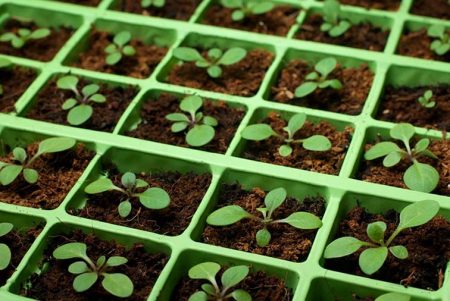
Sowing options for petunia seeds
Method 1. Mixing with sand
Since petunia seeds are very small, it can be problematic to distribute them evenly over the soil surface. Therefore, some growers mix seed with a small amount of soil or sand and scatter it on the surface of the soil.

The container for sowing petunias should be filled with soil and well watered.
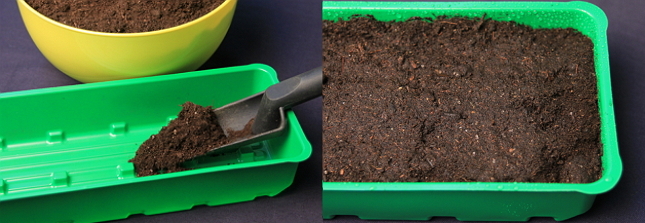
Pour petunia seeds into a plate with a little sand and mix the contents.
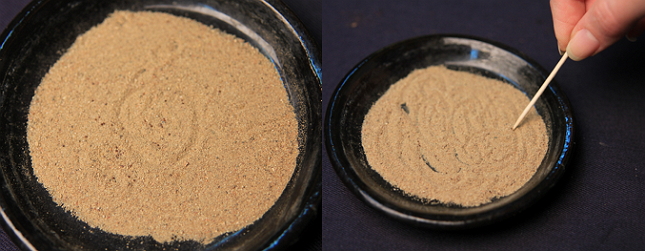
Further, sand with seeds must be evenly distributed over the soil surface.

After that, the crops must be sprayed with water from a spray bottle and sprinkled with soil with a layer of 1-2 mm
Please note that watering the soil from a watering can is not recommended, because in this case the seeds will go deep into the ground, and the seed should be as close to the surface as possible. Some growers do not sprinkle petunia seeds at all after spraying.
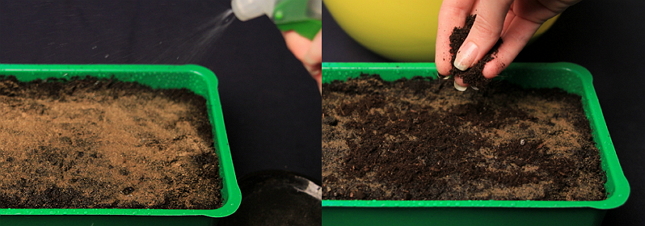
Method 2. Sowing on snow
Another option for sowing petunias is on a layer of snow (1-1.5 cm), which must be laid on the surface of the substrate in a container.
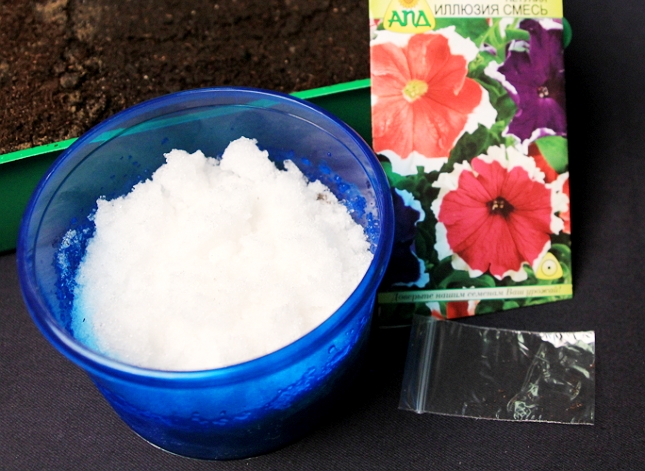
Using a spoon, the snow must be evenly distributed over the surface of the substrate in which you are going to sow petunia seeds.
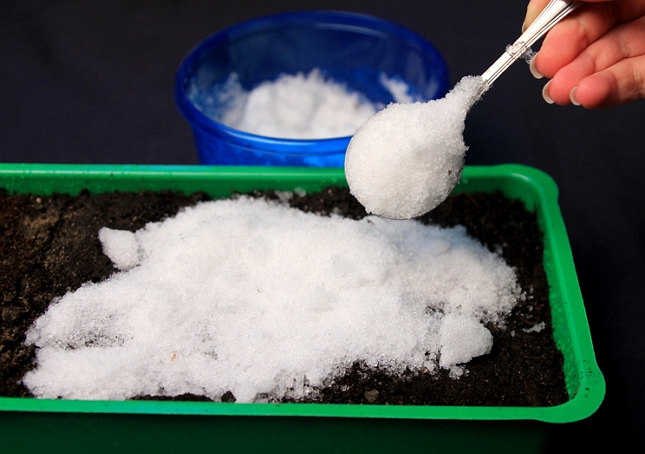
Then the seed should be poured onto the snow cover. The advantage of such sowing is that small petunia seeds are clearly visible on the snow cover. Therefore, even if they are unevenly distributed, they can be easily transferred with a toothpick.
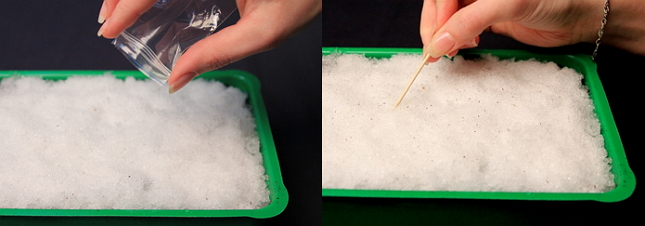
When the snow melts, it will pull the seeds into the substrate to the required depth by itself. Therefore, crops do not need to be sprinkled with soil or watered.
Method 3. Sowing with a toothpick
This method allows you to evenly distribute the seed over the soil surface so that later the seedlings can be conveniently dived.

It is also convenient to use when it is necessary to sow a certain amount of seeds in separate containers, for example, in cassettes.
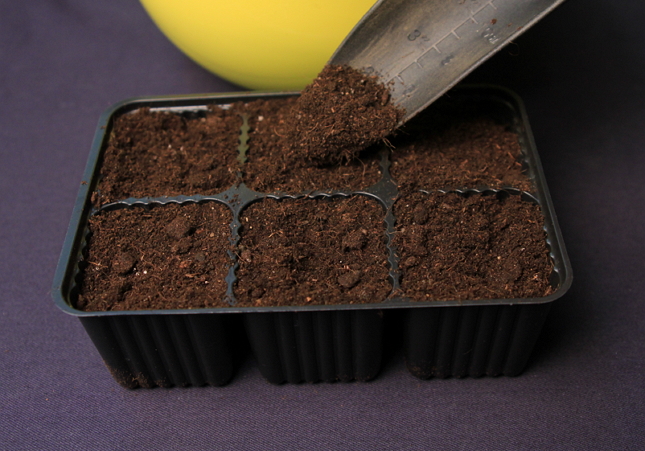
The seeds of petunias should be poured onto a sheet of white paper so that they can be clearly seen. Sowing also requires 2 toothpicks. Since the seeds are very small, it is most convenient to pick them up with the tip of a toothpick dipped in water. You can use a second toothpick (dry) to shake the seed into the soil.
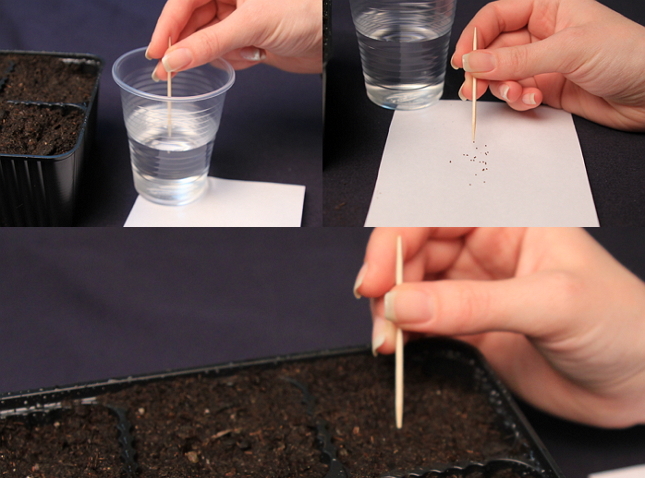
Petunia seedlings care
After the seeds are sown, the container must be covered with glass or foil and placed in a warm place with a temperature of about 20 ° C. To speed up the emergence of seedlings, the soil can be sprayed with a solution of a growth stimulant (for example, Epin).
At the initial stage of growing, petunia crops should be sprayed with a light pink solution of potassium permanganate 1-2 times a day.Later, you can switch to watering with settled melt water. This should be done less often, but the amount of water can be increased.
With the emergence of seedlings, crops should be transferred to the light. If you grow early seedlings of petunias, then it will have to be supplemented, since the plants need at least 12 hours of daylight.
You can dive seedlings when they have 1-2 real leaves. In the middle lane in open ground, seedlings of petunias are planted in the second half of May.
As you can see, sowing petunia yourself and growing a flower of the kind you dreamed of is not at all difficult, the main thing is to follow our recommendations and handle fragile seedlings carefully and carefully, avoiding hypothermia or drying out.


